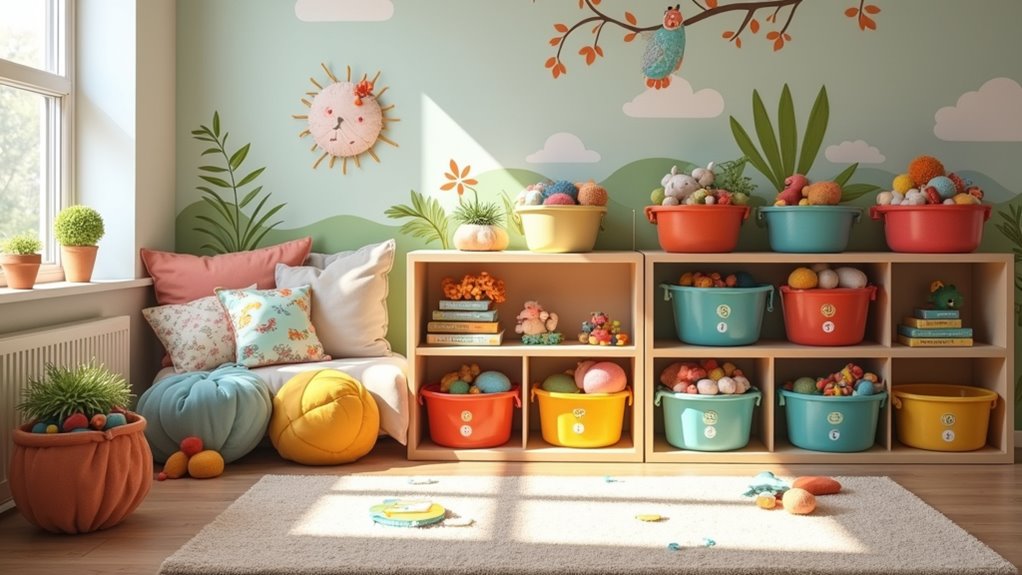To organize your kids' room without losing your mind, start by involving them in the process. Make it fun by turning decluttering into a game and using colorful storage bins. Create functional zones for play, study, and sleep to maintain order. Regularly check in on clutter to keep things tidy. Remember, with routine maintenance and engaging strategies, you can foster a sense of responsibility in your kids. There's more to discover on making this journey enjoyable!
Key Takeaways
- Involve your kids in the organizing process to make it enjoyable and empower them with ownership over their space.
- Use the Four Box Method to efficiently declutter by sorting items into keep, donate, sell, and discard categories.
- Designate functional zones for different activities, using furniture and rugs to visually separate areas and enhance organization.
- Establish a consistent cleaning schedule and nightly tidy-up routines to maintain organization and develop responsibility among children.
- Turn cleaning tasks into games or challenges, and celebrate achievements to boost morale and make the process fun.
Understanding the Importance of Organization
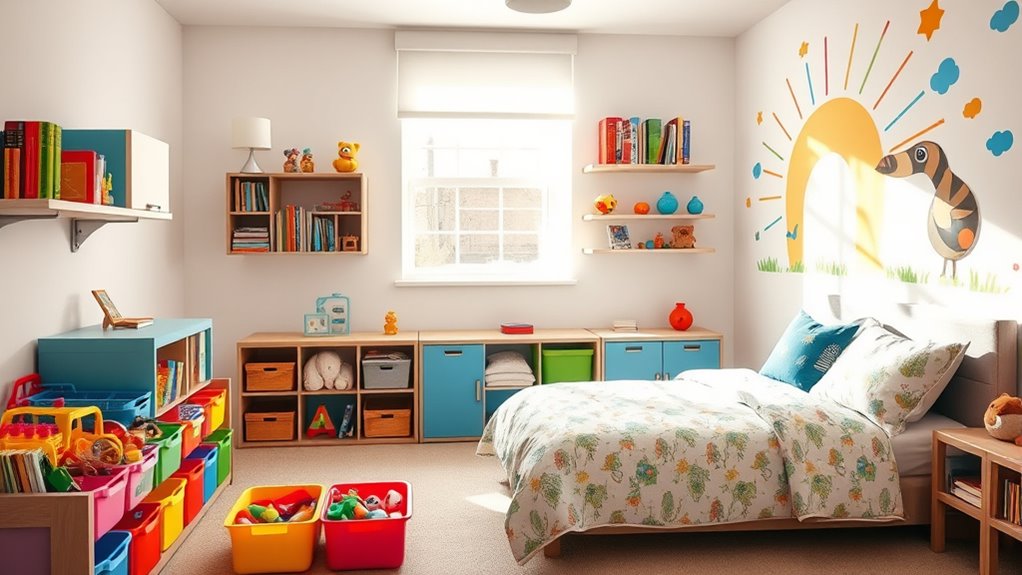
When you prioritize organization in your kids' room, you're not just tidying up; you're enhancing your family's overall quality of life. An organized space improves life balance by helping you manage household tasks more efficiently, giving you extra time for family and self-care. Plus, it boosts productivity, allowing you to tackle more tasks in less time. Reducing clutter creates a visually calming environment, which can significantly decrease stress and promote mental clarity. It also saves you money by curbing last-minute purchases and encouraging planned shopping. By setting clear goals through organization, you pave the way for achieving personal and family aspirations. Ultimately, an organized kids' room fosters responsibility and independence in your children, benefiting everyone in the household. This aligns with the concept of continuous improvement, as it encourages a culture of responsibility and better habits among family members.
Involving Kids in the Process

Involving kids in the organization process not only makes tidying up more enjoyable but also empowers them to take ownership of their space.
Encourage their participation by explaining the benefits of organization, like easier access to toys or a calmer environment. Setting goals together can help them understand what needs to be achieved, as this aligns with the principles of continuous learning emphasized by top entrepreneurs.
Encouraging kids to participate in organization fosters understanding and ownership, making their space more accessible and calming.
Allow them to choose storage solutions or decor that reflect their personality, enhancing their sense of ownership. Model organizational behaviors yourself, showing them the importance of maintaining a tidy space. Teach categorization skills and implement simple systems they can follow. Make it fun by incorporating games or challenges, and always praise their efforts. This creates a positive environment that promotes long-term organizational habits, as involving children in the organization process fosters their comfort with letting go of items.
Decluttering Strategies for Success

Getting kids involved in organizing their room sets a positive tone for the decluttering process.
Start with a blank canvas by removing everything from the room. Next, sort items into categories like toys, clothes, and books. Use the Four Box Method to label boxes as keep, donate, sell, and discard. It's important to remember that decluttering is an ongoing process, so regular check-ins can help maintain the organization. Implementing designated zones for different activities can also make it easier for kids to keep their space tidy.
Purge broken or unwanted items and focus on one area at a time to set realistic goals. Encourage your kids to focus on important items that they truly value.
Create a "Lost and Found" box for misplaced items. Celebrate progress together, acknowledging their efforts as they learn to let go of things they no longer need.
This will foster a sense of accomplishment and ownership.
Creating Functional Zones in the Room
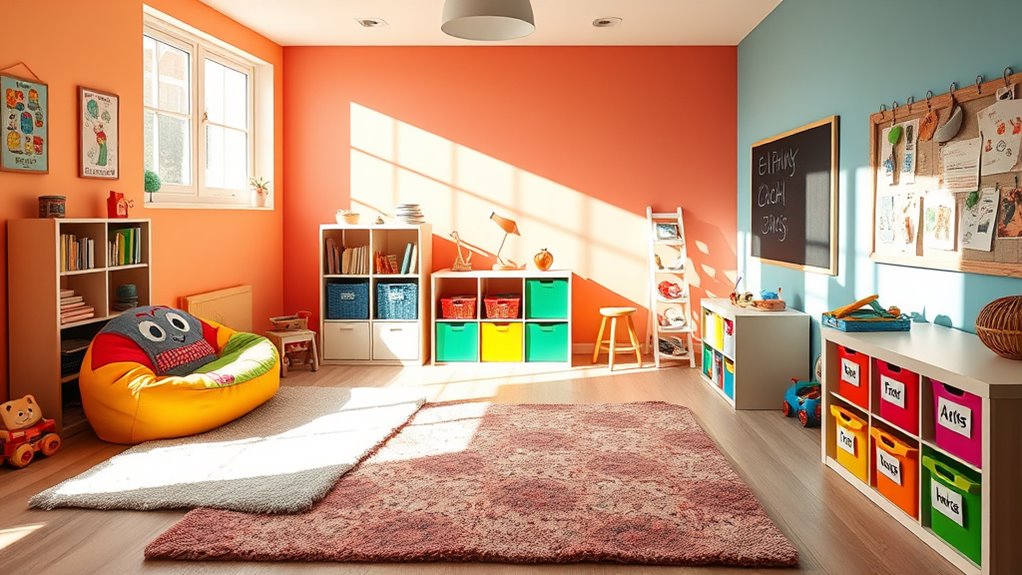
Creating functional zones in your kids' room not only enhances organization but also promotes independence and creativity.
Start by designating specific areas for sleeping, studying, playing, dressing, and relaxing. Use furniture like bunk beds for the sleeping zone and an L-shaped desk for the study zone. Rugs can visually separate these zones while ensuring smooth flow. Incorporating designated zones can help maintain flow and tidiness in the room. Additionally, using hooks for wall organization can keep frequently used items accessible and off the floor.
Designate areas for sleeping, studying, playing, dressing, and relaxing, using furniture and rugs to enhance organization and flow.
Incorporate storage solutions relevant to each activity, like toy boxes in the play zone and closet organizers in the dressing area. Utilize vertical space with wall-mounted shelves and pegboards for additional storage.
Involve your kids in the process, teaching them responsibility and encouraging them to adapt the zones as their interests evolve. This thoughtful layout will empower them and keep the room tidy.
Innovative Storage Solutions
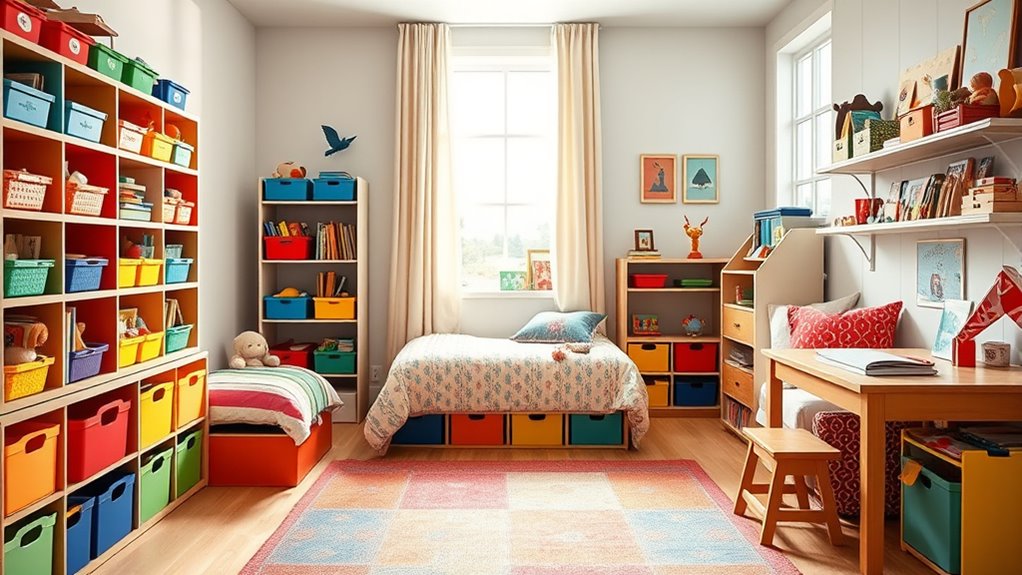
When it comes to organizing your kids' room, innovative storage solutions can really make a difference.
Start by utilizing vertical storage; floating shelves can hold books and small toys, while wall-mounted shelves showcase decorations. Over-the-door organizers are perfect for accessories, and pegboards offer modular storage options. Additionally, adding a spacious kids bookcase helps develop organizational skills and encourages easy cleanup.
Don't forget underbed storage! Use underbed drawers or rolling totes for hidden storage of clothes and toys.
Multi-functional furniture, like beds with built-in drawers, can save space while adding functionality.
For a touch of creativity, consider decorative baskets for toys and colorful bookshelves for both display and storage.
These solutions won't only declutter but also create a more organized and inviting space for your kids.
Implementing a Maintenance Routine
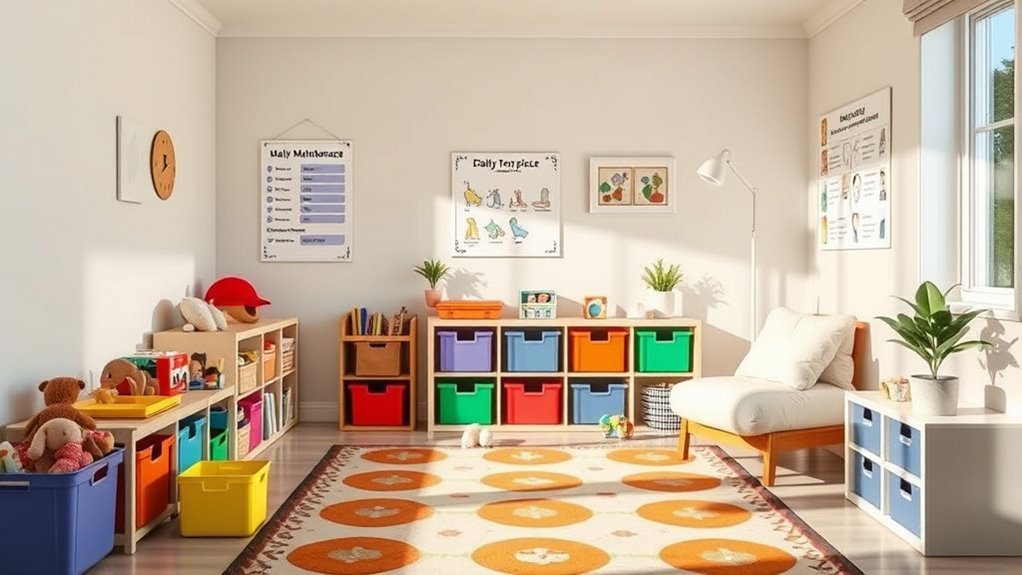
Implementing a maintenance routine is essential for keeping your kids' room organized and clutter-free. Start by establishing a consistent cleaning schedule, whether daily or weekly, and clearly communicate these responsibilities to your kids. Involve your kids in chores to help them develop responsibility and an understanding of the importance of maintaining their space. Encouraging children to learn about emotional intelligence can further enhance their sense of ownership and pride in their environment.
Establish a consistent cleaning schedule and communicate responsibilities to keep your kids' room organized and clutter-free.
Be flexible to accommodate unexpected changes, and involve the whole family to foster collective responsibility. Break down tasks into smaller, manageable steps, assigning age-appropriate duties. Use visual aids like color-coded bins and chore charts to guide them. Incorporate nightly tidy-ups into bedtime routines and plan monthly deep cleans to tackle clutter.
Encourage your kids to take pride in their space and provide regular feedback to reinforce their efforts. By creating a maintenance culture, you'll make organization a shared family value.
Emotional Considerations in Organization
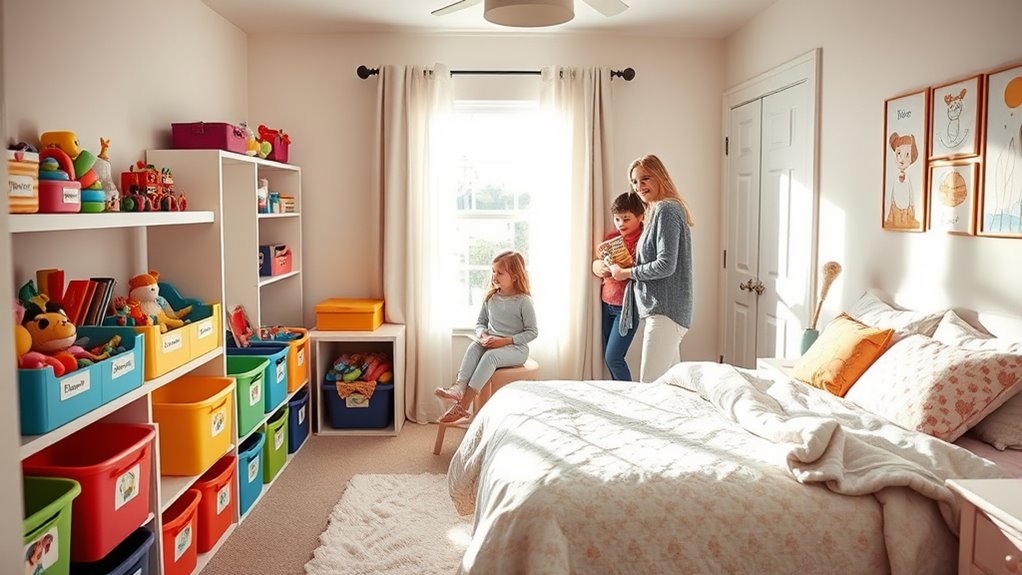
Organizing your kids' room isn't just about tidiness; it plays a crucial role in their emotional well-being. A clutter-free space creates a safe environment, reducing hazards and promoting calmness.
When their room is organized, children feel less overwhelmed, which helps alleviate anxiety. This control over their belongings fosters independence and boosts self-esteem, making them more confident in their surroundings. An organized environment can also improve focus and concentration, enhancing their ability to engage with learning materials effectively.
As kids grow, their organizational needs change; adapting their space encourages emotional growth. Involving them in the process not only teaches responsibility but also gives them a sense of ownership.
Ultimately, a well-organized room supports their creativity and emotional expression, allowing them to thrive in a nurturing environment.
Long-Term Organizational Strategies
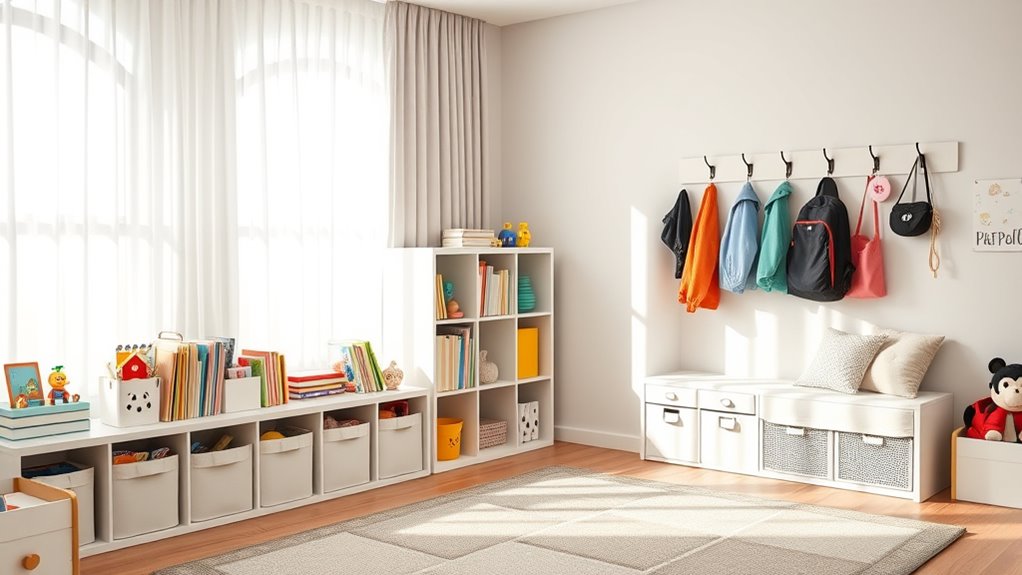
A well-organized room not only nurtures emotional growth but also sets the stage for long-term organization strategies.
Start by dividing the space into functional zones—like a play area, sleeping zone, and study corner. Choose appropriately sized furniture to avoid clutter and ensure safety. Establishing zones can help clarify the purpose of each area, making it easier for children to understand where items belong. Additionally, creating a clutter-free space encourages a sense of calm and focus, which is essential for a productive environment.
Engage your kids in sorting their belongings into keep, donate, or discard categories, teaching them the value of decluttering. Create a collaborative organizational system that reflects their needs and preferences, using labeled storage solutions for easy access.
Establish daily routines, like tidying up before bedtime, to promote responsibility. Regularly review their belongings and encourage participation to foster independence and maintain an organized space over time.
Making Cleaning a Fun Activity
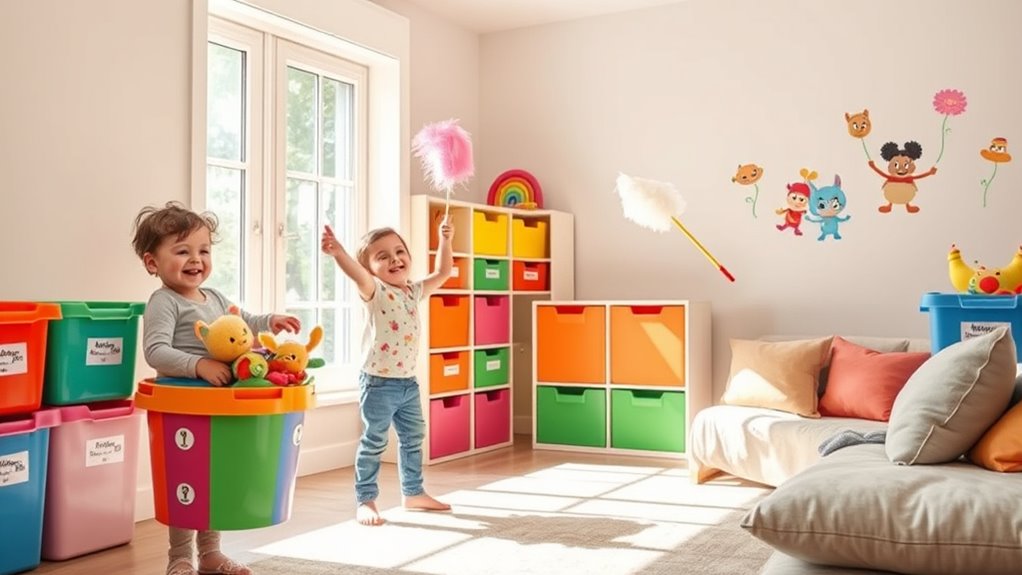
While cleaning might seem like a chore, it can easily transform into a fun activity that kids actually look forward to. Start by providing clear, step-by-step instructions and use visual aids like color-coded bins to make tasks more engaging. Demonstrating cleaning tasks can also help children understand what is expected of them.
Play upbeat music to create a lively atmosphere and consider turning cleaning into games, such as "Clean Your Room BINGO." You can also introduce timed challenges to spark some friendly competition.
Involve your kids in planning and let them choose their tasks, making them feel like leaders. Don't forget to reward their efforts with small prizes or treats.
Celebrating Achievements in Organization
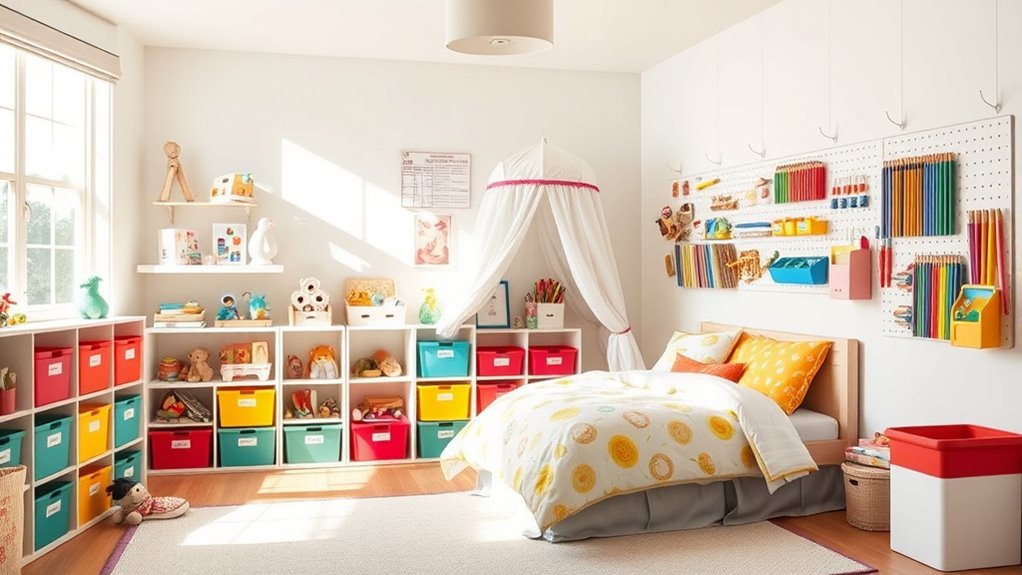
Celebrating achievements in organization not only recognizes hard work but also fosters a sense of community among team members. When you take the time to celebrate, you boost morale and make everyone feel valued. This recognition motivates your kids to keep contributing to their space. Engaging in celebrations encourages creativity, allowing your children to suggest new ways to maintain order. By aligning celebrations with the values you want to instill, you're reinforcing positive behaviors. Consider organizing fun team outings or themed in-home parties to make it special. Additionally, celebrating team success can help create a more cohesive environment, making it easier for everyone to work together towards a common goal.
Publicly acknowledging their efforts can also enhance their sense of accomplishment. These celebrations promote unity and strengthen relationships, making organizing a collaborative and enjoyable experience for everyone involved.
Frequently Asked Questions
What if My Child Refuses to Part With Items?
If your child refuses to part with items, try to understand their feelings. Encourage them to share why they value certain possessions.
You can suggest a "keep" box for their favorites while highlighting the need for space. Make decluttering a fun activity by involving them in decisions about items to donate or recycle.
Gradually introduce the idea of letting go, emphasizing that it's okay to cherish memories without keeping everything.
How Can I Handle Sentimental Items Effectively?
When it comes to handling sentimental items, it's best to take the bull by the horns.
Start by sorting through these treasures and categorizing them based on emotional value. Involve your kids in the process to help them understand what's worth keeping.
Consider creating a memory box for each child to store special items.
Don't forget to regularly review and digitize memories to reduce clutter while preserving what truly matters.
What Age Should Kids Start Organizing Their Own Rooms?
Kids can start organizing their own rooms around age 3. At this stage, you can involve them in simple tasks like putting away toys.
As they grow, encourage them to declutter and set up their own systems by age 5.
By age 6, they'll have the motor skills to manage tasks independently.
Establishing a routine helps them maintain a tidy space and fosters a sense of responsibility as they transition into tweens and teenagers.
How Do I Motivate Kids to Maintain Organization Long-Term?
To keep the flame of organization burning bright, you'll want to inspire your kids with positivity and involvement. Celebrate their achievements, no matter how small, and incorporate fun reward systems to keep them engaged.
Make organization a family affair, turning it into a team adventure. By emphasizing the benefits of a tidy space and allowing natural consequences for chaos, you'll help them develop lasting habits that shine through the years.
What Are Signs That My Child's Room Needs Reorganizing?
If your child's room is overflowing with toys and clothes, it's a clear sign it needs reorganizing.
You might notice they often struggle to find their favorite items or there's barely any space left to play.
If cleaning up feels overwhelming or if messes reappear quickly, those are red flags too.
Involving your child in the process can help turn chaos into an organized space, making it easier for both of you to manage.
Conclusion
In the whirlwind of childhood chaos, organizing your kids' room can feel like catching smoke with your bare hands. But by involving them in the process and creating fun spaces, you'll transform clutter into a harmonious retreat. Embrace the journey, and remember that each small step is a victory worth celebrating. With a sprinkle of creativity and a dash of patience, you'll craft a room that not only sparks joy but also fosters responsibility. Let the adventure begin!
